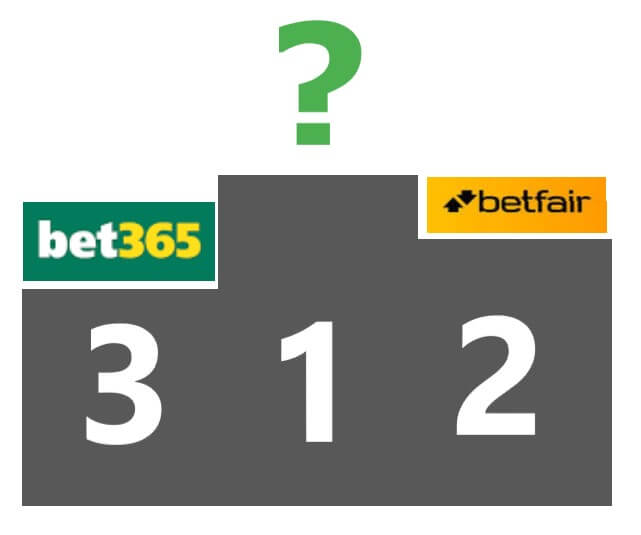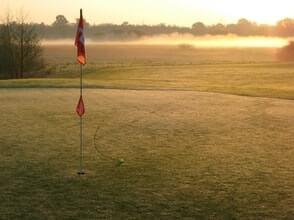Do's and don'ts for the first-time golf bettor
Did you know golf is one of the most generous sports to bet on? The value given, especially within each-way markets is much higher than most.
Betting is like any skill, it takes knowledge, and patients to learn. PGA pros were once beginner golfers, and successful punters were once beginners too.
Here at GolfForecast we've been betting and helping others bet on golf since early 2018. We've seen a lot in the past few years, so here are our top Do's and Don'ts of golf betting.
Do: Follow a strategy
The most important "Do" in golf betting, or any betting, is to follow a strategy. Blindly betting using your gut is a guaranteed way to lose. The trick is building a strategy, verifying its effectiveness, and sticking with it week after week. Members of GolfForecast can attest to this - we've had hundreds of people use our strategy, and the ones who are consistent and patient, see the lucrative benefits. There is no one strategy to follow, you have to do your own research and find out what works best for you. Here's a brief overview of our strategy, to help you understand what goes into it, and help inspire you to get your own (or use ours!).
Our objective
Our primary objective is to look for smaller, consistent wins. We'd rather turn £100 into £200 consistently than turn £100 into £500 here and there. The way to do this is to bet less, on more players. Usually, this consists of splitting your stake (let's say £100) over 20 different players. We also leverage e/w terms, so if we don't pick the winner, we're likely to collect some money back by having ur picks come in the top, 5, 8, or 10.
Now we have to do some maths. The objective is to find undervalued players. Players that the bookmaker thinks won't do well, meaning they'll pay well if they do perform.
The GolfForecast algorithm balances the strike rate and ROI to ensure the user wins consistently, while still building their bank roll.
On average we profit 1 in every 2.5 tournaments and generated an ROI of 74% in 2021. Here’s how:
Step 1
The GolfForecast algorithm forecasts a percentage prediction for each player based on available player data (past 3 years - present), many golf courses data sets and weather.
Step 2
It then gathers odds and each way terms to determine the bookie offering the best value for each golfer.
Step 3
We then determine 'Normalized Bookies Odds' which is what the bookies actually think. It is calculated by taking the best value odds for each golfer available and normalizing them so they sum to 100%. (Essentially, it’s the value of the market if the bookies were to not profit).
Step 4
The algorithm then finds ‘Normalized effective value’ (the real value for each individual each bet). This allows the algorithm to identify which bets are truly undervalued.
Step 5
Our final tip is determined by the difference between our algorithm’s prediction and the effective value, therefore leaving users with the true value for each bet – giving the best odds.
The result
The GolfForecast algorithm takes the top 22% of the field in order to diversify your odds – the result is a much lower risk rate, higher strike rate, and more consistent profits. You win more frequently but not as BIG. Below is a photo of our tips, the ones highlighted in green are our picks. Pay attention to the discrepancy percentage.
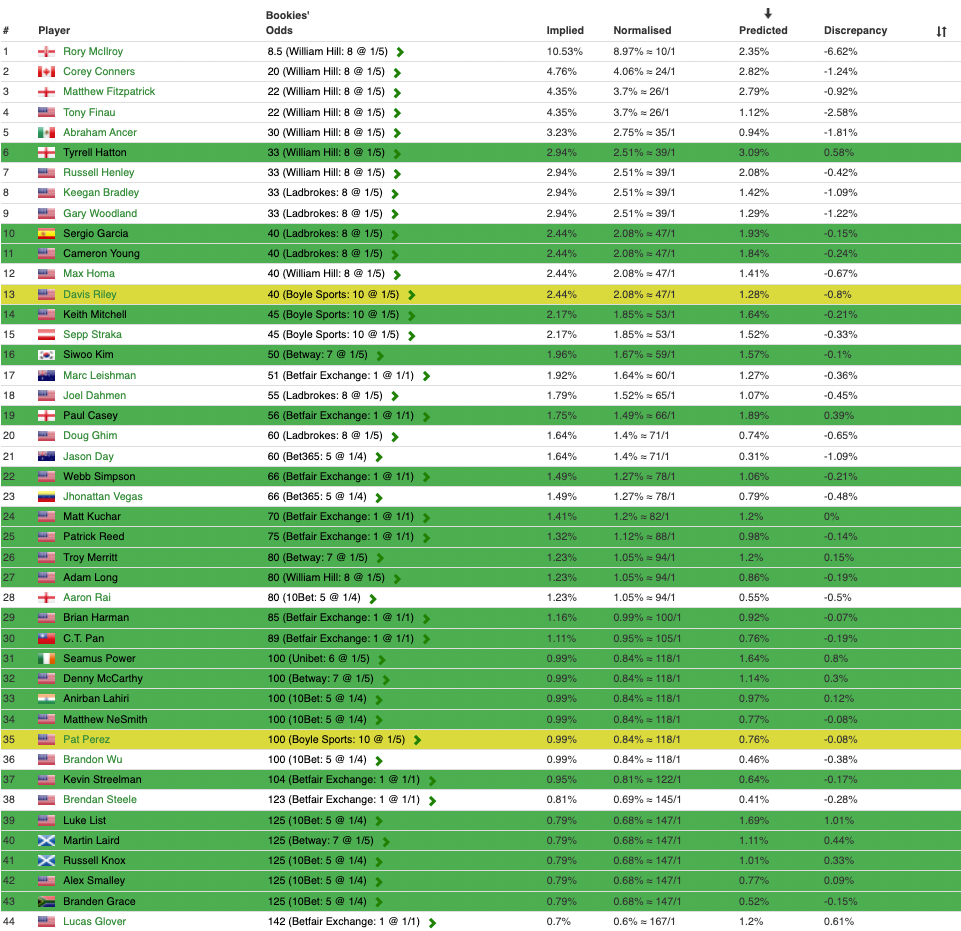
As you can see, the top 22% of discrepancy percentages are picked as our tips. If a player has a high discrepancy percentage but is a long shot, they'll be excluded. This leaves us with the highest value picks possible.
Don't: Cash out your bets
Cashing out bets is just another way for bookmakers to win. Otherwise, they wouldn't offer it to us! Time and time again we see our people cash out what will inevitably prove to be winning bets, sometimes at the worst time possible, and even when the bets didn't turn out to be winners, there’s a margin built in that big enough to ensure the bookie wins in the long run. All in all, unless cashing out is built into your strategy, doing it demonstrates inconsistency, lack of value, and most likely you acting with emotion.
Do: Be patient!
A big thing we see within our community is a lack of patience. People expect results immediately, and all the time... unfortunately, not possible. Below is our strategies results graph. You can see that it does go down at certain points, but the main takeaway is the overall trendline is positive. Let's make this really clear: over a small amount of time, you may or may not make money. Over a long period of time, you WILL make money. Ride the waves.
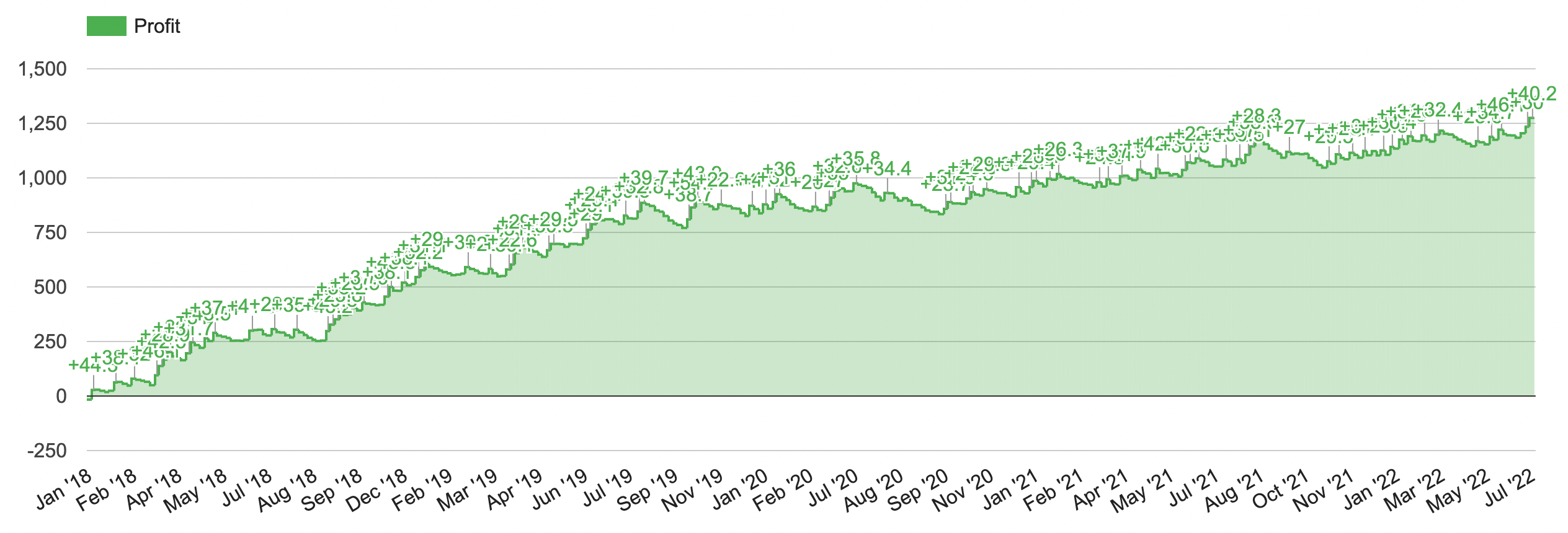
Don't: bet with just one bookmaker
The easiest way to increase value within your bets is leveraging the markets. Just like finding the best deal for a golf club online, you have to shop around. First, you must look at the market's overall value. GolfForecast provides this analysis for free on our website for every tournament (see example photo below).
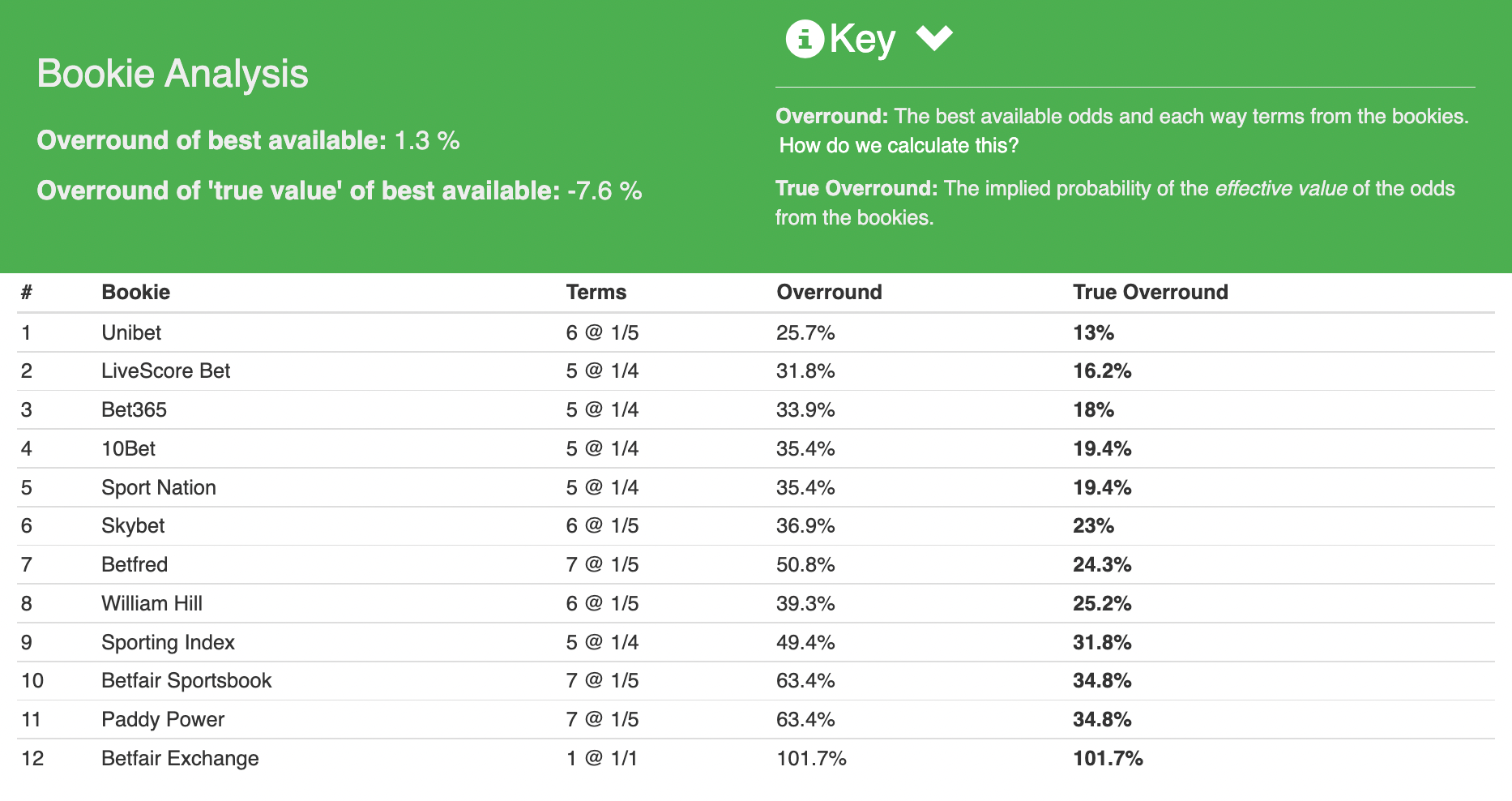
We gather all the available odds and terms from the top bookmakers to see who's best to bet with overall. As you can see, Unibet is #1. We won't go too deep into what everything means, but looking at Unibets True Overround of 13% compared to Paddy Power 34.8%, we can gain an extra 21.8% in value just by using Unibet over Paddy Power.
Do: Use each-ways generous odds & terms
We did a full-blown analysis on this subject that you can read here: Should you be e/w on golf? Our overall recommendation is to leverage e/w - this is the more risk-averse approach and isn't considered less valuable than using outright winners. It will always reduce swings within your bankroll, allowing for a less volatile trend and more peace of mind for the punter. Our conclusion to our e/w analysis linked above is this:
"We at GolfForecast conclude that a split of 200 is optimal and thus all bets with odds greater than 200/1 should be placed each way. And that for odds smaller than 200/1 the choice is yours as the difference is negligible in the long-term."
Don't: Bet on just a few players
By tipping more players, you balance strike rate with ROI and allow yourself to take advantage of the power of compound interest. The question is, how many players should I aim to bet on? We've done the math on this, and the sweet spot is 22% of the field, roughly 22 players. Why?
Safer
You can stake a greater percentage of your bank, per event (or start with a smaller bank).
Consistent
More consistent returns mean you can better take advantage of compound interest.
Do: Spread your bets out
Just because you bet £10 on a player with odds are 25/1, doesn't mean you should bet £10 on your bet that's 150/1. Why? because we want to aim for each bet to generate the same return. If your 25/1 bet comes through, it should be the same return as if your 150/1 bet returns. This is simple, you bet more on the players likely to win, and less on the players who don't. 5 125/1 bets at £2 equal 1 25/1 bet at £10.
Here at GolfForecast, we distribute a member's stake according to their stake per event. Tell us how much you'd like to bet, and we'll tell you exactly how much to bet on each player. Learn how we do this by reading our stake per event article.
Don't: Bet on favorites
Favorites surprisingly don't win very often, 7.81% of tournaments to be exact. We did the maths and analysis here. We've determined that they're not valuable, and the winner of more than 90% of tournaments has odds between 22/1 and 150/1.
Do: Bet by determining value
Adding to our section related to strategy, determining value is the only way to bet. A coin that flips head 52% of the time may flip tails more times than heads over a small sample size, however over a large sample size heads will win more than tails. Here's a good post from a member of our GolfForecast Facebook group.

Do: Track your bets!
Assuming you follow our advice with using multiple bookmakers, you won't be able to see a profit/loss chart within your account history, as your bets will be spread across multiple bookmakers. Your best bet is to use a spreadsheet, this will help you keep track of your profits (or losses if your strategy is bad). Here's a demo we've made for our members, feel free to use it yourself. Free profit tracking sheet.
Don't: Bet too much money
Betting too much money will lead your account to hit zero. When we say "too much money" we mean relative to your bankroll. If you have £1000, betting £500 on a tournament is too much, but if you have £5000, then betting £500 is not. The first step is giving your strategy a risk score. Our strategy has a risk score of 10, which means members should bet 10% of their total bankroll. If you start with £300, you'll bet £30 per tournament.
Do: Compound your stakes
Here's a little golden nugget. Ready? Compounding your stakes is the way to riches. Obviously, this takes time, because you have to first build up your bankroll. However, while doing that, you can verify your strategy, and by the time you have more money to compound your stakes, you'll know your strategy is reliable! That's the real goal to all this, build your bankroll to the point where you're staking enough to make significant gains. For example, if your strategy has an annual return of 90% (This was ours last year), then having a bankroll of £1000 means you'd end the year with £1900. Not bad. Now let's say, someone started the year with £20,000, they'd end the year with £38,000. That's impressive!
Conclusion:
We hope you're ready to take your golf journey successfully over to the bookmakers- it's not just a fun sport to play, but also to bet on. Golf betting is just like a golf game, you need the right tools to be successful, or even play at all. The golf course is your strategy, consistency is your practice putting green, patience are your practice swings, using multiple bookmakers are your playing partners and other golfers, distributing your stake are your golf clubs, golf glove, ball marks, golf balls, golf bag, and golf cart. Lastly, your profit tracking is your golf swing. Now you're ready to hit the golf ball.

